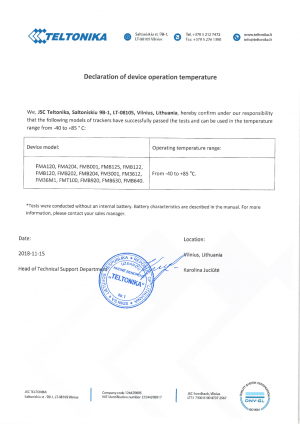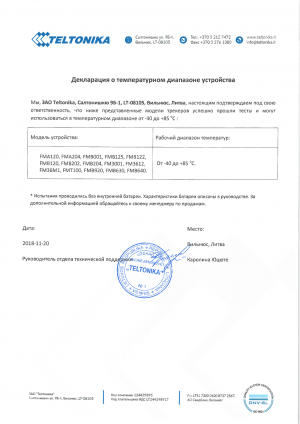|
|
| (42 intermediate revisions by 3 users not shown) |
| Line 1: |
Line 1: |
| − | An operating temperature is the temperature at which an electrical or mechanical device operates. The device will operate effectively within a specified temperature range which varies based on the device function and application context, and ranges from the minimum operating temperature to the maximum operating temperature (or peak operating temperature). Outside this range of safe operating temperatures the device may fail.
| + | {{Declaration of device operation temperature}} |
| | | | |
| − | __TOC__
| + | ==Attachments== |
| − | ==Ranges== | + | <div><ul> |
| − | Most devices are manufactured in several temperature grades. Broadly accepted (?) grades are:
| + | <li style="display: inline-block;"> [[image:Temperature declaration.png|thumb|left|300px|Declaration of device operation temperature 2018-11-15]] </li> |
| − | *Commercial: 0 ° to 70 °C
| + | <li style="display: inline-block;"> [[image:Декларация о температурном диапазоне устройства.png|thumb|left|300px|Декларация о температурном диапазоне устройства 2018-11-20]] </li> |
| − | *Industrial: −20 ° to 85 °C
| + | </ul></div> |
| − | *Military: −55 ° to 125 °C
| + | [[Category:FMB920 Certification & Approvals]] |
| − | The use of such grades ensures that a device is suitable for its application, and will withstand the environmental conditions in which it is used. Normal operating temperature ranges are affected by several factors, such as the power dissipation of the device. These factors are used to define a "threshold temperature" of a device, i.e. its maximum normal operating temperature, and a maximum operating temperature beyond which there is no guarantee that the device will continue to function as intended.
| |
| − | | |
| − | | |
| − | ==Structure of the IMEI and IMEISV (IMEI software version)==
| |
| − | The IMEI (15 decimal digits: 14 digits plus a check digit) or IMEISV (16 decimal digits: 14 digits plus two software version digits) includes information on the origin, model, and serial number of the device. The structure of the IMEI/SV is specified in [http://www.3gpp.org/ftp/Specs/html-info/23003.htm 3GPP TS 23.003]. The model and origin comprise the initial 8-digit portion of the IMEI/SV, known as the Type Allocation Code (TAC). The remainder of the IMEI is manufacturer-defined, with a Luhn check digit at the end. For the IMEI format prior to 2003, the GSMA guideline was to have this Check Digit always transmitted to the network as zero. This guideline seems to have disappeared for the format valid from 2003 and onwards.
| |
| − | | |
| − | As of 2004, the format of the IMEI is ''AA-BBBBBB-CCCCCC-D'', although it may not always be displayed this way. The IMEISV does not have the Luhn check digit but instead has two digits for the Software Version Number (SVN), making the format ''AA-BBBBBB-CCCCCC-EE''
| |
| − | | |
| − | Prior to 2002, the TAC was six digits long and was followed by a two-digit Final Assembly Code (FAC), which was a manufacturer-specific code indicating the location of the device's construction.
| |
| − | From January 1, 2003 until that April 1, 2004, the FAC for all phones was 00.
| |
| − | After April 1, 2004, the Final Assembly Code ceased to exist and the Type Allocation Code increased to eight digits in length.
| |
| − | | |
| − | In any of the above cases, the first two digits of the TAC are the Reporting Body Identifier, which identifies the GSMA-approved group that allocated the TAC. The RBI numbers are allocated by the Global Decimal Administrator. IMEI numbers being decimal allows them to be distinguished from an MEID, which is hexadecimal and always has 0xA0 or larger as its first two hexadecimal digits.
| |
| − | | |
| − | For example, the old style IMEI code 35-209900-176148-1 or IMEISV code 35-209900-176148-23 tells us the following:
| |
| − | <blockquote> | |
| − | '''TAC''': 35-2099 - issued by the BABT (code 35) with the allocation number 2099<br/>
| |
| − | '''FAC''': 00 - indicating the phone was made during the transition period when FACs were being removed.<br/>
| |
| − | '''SNR''': 176148 - uniquely identifying a unit of this model<br/>
| |
| − | '''CD''': 1 so it is a GSM Phase 2 or higher<br/>
| |
| − | '''SVN''': 23 - The "software version number" identifying the revision of the software installed on the phone. 99 is reserved.
| |
| − | </blockquote>
| |
| − | | |
| − | By contrast, the new style IMEI code 49-015420-323751 has an 8-digit TAC of 49-015420.
| |
| − | | |
| − | The new CDMA Mobile Equipment Identifier (MEID) uses the same basic format as the IMEI.
| |
| − | {{IMEI description}}
| |
| − | | |
| − | ==Attachements==
| |
| − | | |
| − | [[image:TM25_DIA.png|thumb|left|300px|TM2500 Declaration of IMEI assignment 2018-05-17]] | |
Description
An operating temperature is the temperature at which an electrical or mechanical device operates. The device will operate effectively within a specified temperature range which varies based on the device function and application context, and ranges from the minimum operating temperature to the maximum operating temperature (or peak operating temperature). Outside this range of safe operating temperatures the device may fail.
Ranges
Most devices are manufactured in several temperature grades. Broadly accepted grades are:
- Commercial: 0 ° to 70 °C
- Industrial: −20 ° to 85 °C
- Military: −55 ° to 125 °C
The use of such grades ensures that a device is suitable for its application, and will withstand the environmental conditions in which it is used. Normal operating temperature ranges are affected by several factors, such as the power dissipation of the device. These factors are used to define a "threshold temperature" of a device, i.e. its maximum normal operating temperature, and a maximum operating temperature beyond which there is no guarantee that the device will continue to function as intended.
Attachments
-

Declaration of device operation temperature 2018-11-15
-

Декларация о температурном диапазоне устройства 2018-11-20

